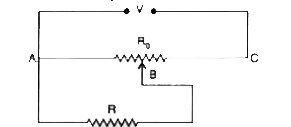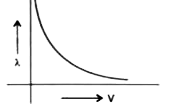Show graphically, the variation of the de-Broglie wavelength (λ) with the potential (V) through which an electron is accelerated from rest.Solution in Kannada
Topper's Solved these Questions
- BOOK - OSWAAL PUBLICATIONCHAPTER - DUAL NATURE OF RADIATION AND MATTEREXERCISE - TOPIC-2 DE-BROGLIE RELATION (SHORT ANSWER TYPE QUESTIONS-I)9videos
DUAL NATURE OF RADIATION AND MATTER
- BOOK - OSWAAL PUBLICATIONCHAPTER - DUAL NATURE OF RADIATION AND MATTEREXERCISE - TOPIC-2 DE-BROGLIE RELATION (SHORT ANSWER TYPE QUESTIONS-II)2videos
DUAL NATURE OF RADIATION AND MATTER
- BOOK - OSWAAL PUBLICATIONCHAPTER - DUAL NATURE OF RADIATION AND MATTEREXERCISE - TOPIC-1 PHOTOELECTRIC EFFECT (NUMERICAL PROBLEMS)15videos
DUAL NATURE OF RADIATION AND MATTER
- BOOK - OSWAAL PUBLICATIONCHAPTER - CURRENT ELECTRICITY EXERCISE - TOPIC-3 (POTENTIOMETER & APPLICATIONS) (NUMERICAL PROBLEMS)2videos
CURRENT ELECTRICITY
- BOOK - OSWAAL PUBLICATIONCHAPTER - ELECTRIC CHARGES & FIELDSEXERCISE - (TOPIC -2)Numerical Problems5videos
ELECTRIC CHARGES & FIELDS
Similar Questions
What are matter waves? Derive an expression for the de Broglie wave length.
02:23View SolutionAn electron and a photon each have a wavelength of 1.00 nm. Find (i) their momentum (ii) the energy of the photon and (iii) K.E of electron
04:37View SolutionThe threshold wavelength of a photosensitive metal is 662.5 nm. If this metal is irradiated with a radiation of wavelength 331.3 nm, find the maximum kinetic energy of the photoelectrons. If the wavelength of radiation is increased to 496.5 nm, calculate the change in maximum kinetic energy of the photoelectrons. (Planck's constant h=6.625×10−34 Js and speed of light in vacuum=3×108ms−1)
02:36View SolutionA resistance of RΩ draws current from a potentiometer. The potentiometer has a total resistance R0Ω.A voltage V is supplied to the potentiometer. Derive an expression for the voltage across R when the sliding contact is in the middle of the potentiometer.
 02:27View Solution
02:27View SolutionAn atom was earlier assumed to be sphere of radius a having a positively charged point nucleus of charge +Ze at its centre . This nucleus was believed to be surrounded by a uniform desity of negative charge that made the atom neutral as a whole.
Use this theorem to find the electric field of this atom at a distance r(r>a) from the centre of the atom.01:08View SolutionAn electron of mass m when accelerated through a potential difference V has de - Broglie wavelength λ. The de - Broglie wavelength associated with a proton of mass M accelerated through the same potential difference will be
02:51View Solutionde-Broglie wavelength associated with an electron accelerated through a potential difference V is λ. What will be its wavelength when the accelerating potential is increased to 4V?
04:55View SolutionAn electron of mass 'm', when accelerated through a potential V has de-Broglie wavelength lambda . The de-Broglie wavelength associated with a proton of mass M accelerated through the same potential difference will be:
01:24View Solutionde Broglie wavelength associated with an electron acclerated through a potential difference V is λ. What will be its wavelength when the accelerating potential is increased to 4V?
02:48View SolutionThe de Broglie wavelength λ of an electron accelerated through a potential V in volts is
03:44View SolutionAn electron accelerated through a potential of 10,000 V from rest has a de-Broglie wavelength lambda . What should be the accelerating potential so that the wavelength is doubled?
03:44View SolutionAn electron of mass m when accelerated through a potential difference V, has de Broglie wavelength λ. The de Broglie wavelength associated with a proton of mass M accelerated through the same potential difference, will be :-
03:11View SolutionAn electron accelerated through a potential of 10000 V from rest has a de Broglie wavelength λ. What should be the accelerating potential so that the wavelength is doubled?
04:22View SolutionThe de Broglie wavelength of electron accelerated with a potential V is ____________.
03:26View SolutionThe de Broglie wavelength associated with an electron accelerated through a potential differenece V is lambda . What will be its wavelength when the accelerating potential is increased to 4V ?
02:37View SolutionThe de Broglie wavelength associated with an electron accelerated through a potential differenece V is λ. What will be its wavelength when the accelerating potential is increased to 4V ?
03:55View Solution


